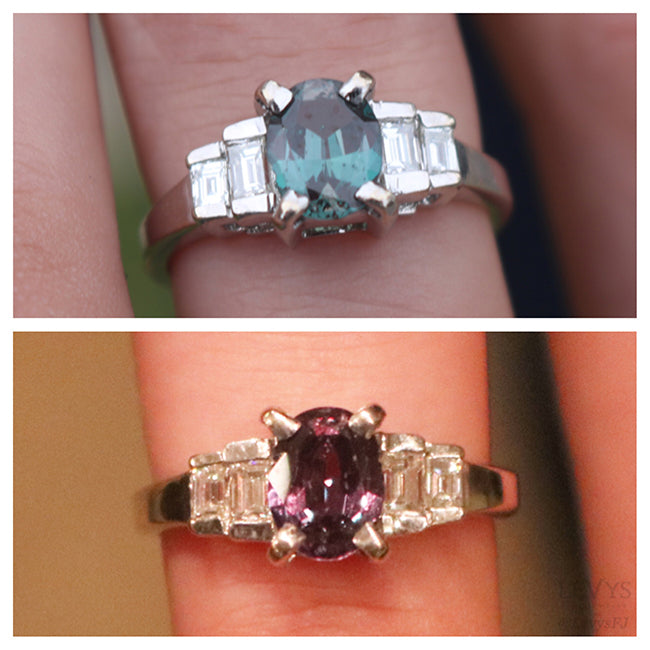
September21
What Stones Change Color Other Than Alexandrite?
Alexandrite was the first color changing stone ever discovered, and the intensity of the color change causes it to be one of the most highly valued gemstones in the world. It also ranks really high on a Moh’s scale (8.5), so it’s not a stone that gets destroyed from every day wear.
High quality alexandrite is valued based on size, of course, but the intensity of the color change plays a larger role in determining value. The strong color change stones will be a vivid intense green under natural light and a beautiful deep red under artificial light.
While natural alexandrite is the most famous color changing stones, there are other stones that experience just as strong of a color change.
@levysfj "Emerald by day, ruby by night" - natural alexandrite appears green under natural light and red under artificial light 🌞🕯 What do you think about this unique ring? #alexandrite #gemtok #raregem ♬ Change - ONE OK ROCK
Sapphire
The most durable and valuable of all of the color changing gemstones on this list is color change sapphire. The color difference is usually not quite as extreme as with a high quality alexandrite, but it’s definitely noticeable. As with all color changing stones, the more extreme the difference in color, the more valuable the stone.
Color change sapphires can transition from blue to red, red to brown, blue to violet, green to red or green to yellowish green. Color change sapphires are beautiful stones, but they are very rare, especially in large sizes. Synthetic color change sapphires are fairly common, transitioning from a deep blue to a rich purple depending on lighting conditions.

Garnet
Color change garnet is another beautiful collector stone that is durable enough to be worn consistently in jewelry. The change of color in these garnets can be subtle, like a stone that transitions from golden to a more pure orange, or more extreme like a green to a red. Other color change combinations can be dark blue to brownish red, blue to violet, blue to red, violet to red, green to brown or red to a more purplish red.

Andesine
Andesine is a unique stone which is most often found in red, green and yellow. The color changing version of this stone switches from green under natural light to a reddish orange or purple/violet color under incandescent light. Andesine measures as a 6-6.5 on a Mohs scale of hardness, so expect it to eventually become worn if you choose to wear it every day in a ring.
Diaspore (Zultanite)
Color changing diaspore is most commonly known by it’s trade name, Zultanite. This unique stone exhibits a strong pleochroism, so the stone may appear to show different colors from different angles, without even adjusting the light. The most common colors exhibited in zultanite are yellow or green to a red or reddish brown. Diaspore ranks as a 6.5-7 on a Mohs scale, so it’s harder than a lot of the stones on this list, but it’s a very rare stone, only commercially mined in Turkey, so it’s not something you’re going to see a lot.

Fluorite
Fluorite is a common stone to find amongst mineral collectors due to its vivid color and how commonly it exhibits strong color zoning with different colors. Unfortunately, it’s color has a tendency to dull with too much light. It also measures as a 4 on the Mohs scale, so it’s not the most suitable stone to use for jewelry. The most common color transition for color changing fluorite is from blue to purple or violet.
Spinel
Spinel is another stone that is rather durable, measuring a 7.5-8 on the Mohs scale. It is commonly found in intense reds, pinks or blues, but sometimes, it will shift from blue to a shade of purple or dull red. The color changing form of spinel is very rare in large sizes, so it’s not something that you are going to see super frequently.

Glass/CZ
Like so many other phenomenal effects in gemstones, humans have learned to replicate the color change effect of certain stones in man-made glass or CZ form. Color change CZ is most frequently going to mimic alexandrite by appearing green under natural light and orange or red under incandescent light. Color changing glass also most commonly mimics alexandrite (because it is the perceived as the most valuable stone exhibiting this effect), but it can sometimes mimic other stones. The example below is a manmade glass ring with incredibly strong color changing mimicking zultanite.
@levysfj Can you guess the stone? 🔮 #color #colorchallenge #ring #jewelry #workdistractions #retailtherapy #ringchallenge #ringlover #fashion #foryou #fyp ♬ original sound - rin

